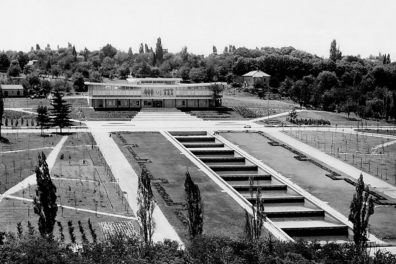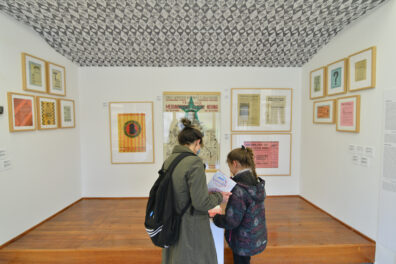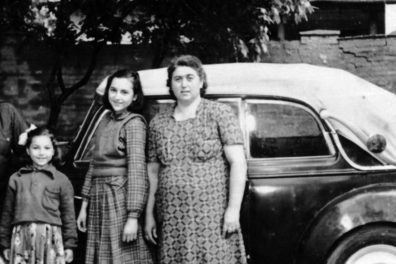Around the world in 23 minutes
The Old Museum - Exhibition Room I
The Old Museum - Exhibition Room II
The Old Museum - Exhibition Room III
The Old Museum - Exhibition Room IV
The Old Museum - Exhibition Room V
We are presenting the ethnographic collection of the Museum of Yugoslav History as a unique collection of rarities. The title, Around the World, is intended to emphasise the variety of origin of the items. In the permanent exhibition of the Old Museum we have focused on the exclusive quality of certain items.
On this trip Around the World, you will learn why the Montenegrins used to dress elegantly, what kind of music people listen to in Indonesia, why Ethiopian shields look like hats, why sabres are curved, what the symbolic meaning is of the knife of a chief of the African Mombutu and much more.
NATIONAL COSTUMES OF THE PEOPLES OF SFR YUGOSLAVIA
Montenegrin national costume. Clothing is a way of expressing identity. The look of a national costume is a result of the diversity of cultural influences and social and historic conditions. Incorporated in the Montenegrin national costume were elements of formal mediaeval middle-class clothing, traditional Greek clothing and traditional folk clothes. This quickly became a national costume which expresses the unity of the people. The value of the costume was as a symbol of defiance against the Turkish authorities.
Džube: The principal difference between village and city traditional clothing in the Balkans is the fact that even after industrialisation, until the beginning of the twentieth century, women made clothes by hand, while in the city there were tradesmen specialised in the manufacture of garments. The džube is part of the city women’s national costume, of the Oriental type, handcrafted and embroidered with gold and silver thread. It belongs to the Central-Balkan type of national costume with typical elegant, elongated shapes. It was worn by women from all ethnic communities.
Toke: part of the men’s national costume of the Dinaric type. It is presumed that these were also once used for defence but that, from the nineteenth century, their function is purely decorative. The toke symbolises heroism, glory and wealth.
MUSICAL INSTRUMENTS
Angklung, Bandung, Indonesia. The angklung is today popular and is found throughout Southeast Asia. It is made of bamboo. The base of the frame is held with one hand while the other hand shakes the instrument rapidly from side to side, causing a rapidly repeating note to sound. The sound is produced by two tubes attached to the frame. They are carved and tuned in such a way that they produce two notes either an octave or a fifth apart. Because of this the ensemble consists of at least three performers who together complete the harmonies in which each plays a different note.
HANDMADE WEAPONS
Shashka. This is a sabre originating among the nomadic tribes of the Caucasus and later adopted by Russian and Ukrainian Cossacks. It is characterised by the absence of a guard between the blade and the hilt. In terms of blade curvature, the shashka is midway between a full sabre and a sword.
Shamshir. (Lion’s tail or lion’s claw sabre). This is a group of sabres with very curved blades, all of which originate from the Turko-Mongol sabre. Although there were effective techniques for attacking an opponent with the blade of an ordinary sword, sabres such as the shamshir had an advantage because they were made precisely for this purpose. They were more aerodynamic and easier to handle, especially when on horseback.
Yatagan. Turkish long knife. These appear for the first time in the middle of the sixteenth century. From that time they were used extensively in areas under Turkish rule. Because of its proven efficiency the yatagan is among the very few weapons whose appearance did not change over time and which remained the same in all parts of the empire. Because of its appearance, the hilt of the yatagan is called the croup, as in the hindquarters of a horse. When hand-held firearms appeared, the croup of a yataghan, dug into the ground, was used as a stand for the matchlock muskets carried by the Turks. In 1878, the Austrian authorities banned the use of the yatagan.
Flintlock grenade launcher. The flintlock grenade-launching rifle comes from Tunis and dates from the fourth decade of the nineteenth century. It is notable for the emphasised flare of the muzzle which widens like a trumpet. These rifles discharged bullets broadly but had a short range, so were used by cavalry for shooting from close range and in assault attacks.
Shields, Ethiopia. Ethiopian shields were made from rhinoceros, antelope or elephant hide. They are of Asian origin. The arched structure provides great resistant strength. The shape is achieved by stretching the hide over a stone. These shields were used in the Ethiopian-Italian war of 1935.
The pištala rifle is made of two parts: a long wooden stock and a cast iron barrel. The pištala is the oldest firearm which is activated by lighting a fuse at the end of the barrel. The detonation mechanism resembles that in cannons and other mediaeval firearms. The name is onomatopoeic, referring to the hissing sound the rifle makes.
Tanto. This traditional Japanese double-edged knife was the shortest of the three swords worn by samurai. Women wore one small tanto, the kaiken. This exhibit is a woman’s tanto or kaiken, dating from the mid-fourteenth century. It was customary for women to receive the kaiken as a wedding gift and to carry it in the obi, the traditional sash worn with the kimono (see Gallery 5). It was used for self-defence. In modern times, the kaiken has become part of the traditional Japanese wedding, carried by the bride to bring good luck.
Sickle knife of chief. The Mangbetu people of North-East Congo are renowned for their artistic talent. The handle of the knife is of ivory, phallic in shape, symbolising the masculinity and fertility of the chief. There are two elongated skulls at the end, as an anthropological feature and the aesthetic ideal of this people. In order to achieve this head shape, the heads of babies were firmly bandaged at birth with cotton fabric. Because the skull bones have still not grown together, this would result in artificially deformed skulls of elongated shape.
Katar. This dagger dates from the Maratha Empire, which encompassed the greater part of Central India from 1674 to 1818. Notable for its horizontal hand grip, the katar is more an extension of the fist than a knife. Instead of cutting, which is the case with an ordinary dagger, the opponent is stabbed with a direct hit. The katar has a hollow blade from which a smaller blade emerges when the hilt is pressed. The katar ceased to be in common use from the nineteenth century.
VARIOUS ETHNOGRAPHIC ITEMS
Carnival costume, Oruro, Bolivia. In Bolivia, mining is a major industry. This costume from the La Diablada Carnival is a representation of the god of mountains. The cult of this god developed strongly among the mining communities in the area around Lake Titicaca. With the arrival of Christianity, this divinity came to be identified with the devil, thus the current name of the carnival – La Diablada. Every February, the devil is exorcised from the mines with dances and songs. In 2001, UNESCO protected this carnival as a Masterpiece of the Oral and Intangible Heritage of Humanity.
Hungarian men’s national costume. From the nineteenth and early twentieth century. This traditional costume is characterised by the front skirt or apron which is a typical element of women’s costume in other nations, thus this Hungarian men’s garment is an exception.
Kimono. The kimono is made from a single piece of silk. There are many types of kimonos and many different ways in which they are worn. Each detail in the way of dressing has a special meaning and carries a message. Young unmarried women wore light-coloured kimonos with ankle-length sleeves. Married women wore kimonos with shorter sleeves to indicate that the woman was no longer free. The sash on the kimono, the obi, is made of hand-woven silk and so may often be worth as much as the kimono itself. It is very long and is wrapped several times around the body and tied at the back. There were various ways of tying the obi, all of which carry different meanings. Allegedly only geisha tied them in the front so they could more easily be untied. The women of samurais carried their kaiken knives in their obis.
Indonesian puppets. The Indonesian theatre, wayang, is mentioned for the first time in a manuscript dated 930. There are several forms of puppet theatre in Indonesia of which shadow puppets are the most popular. The puppets exhibited here are from the wayang golek form, which probably came from China to Java in the seventeenth century. The theme of the plays is the struggle between good and evil. Formerly, performances would last three days and three nights without interruption and the main performer, the dalang both played instruments and narrated. For this reason the dalang is highly respected. Even today performances may last several hours and dalang enjoy the status of stars.

The Origins: The Background for Understanding the Museum of Yugoslavia
Creation of a European type of museum was affected by a number of practices and concepts of collecting, storing and usage of items.

New Mappings of Europe

Museum Laboratory
Starting from the Museum collection as the main source for researching social phenomena and historical moments important for understanding the experience of life in Yugoslavia, the exhibition examines the Yugoslav heritage and the institution of the Museum

